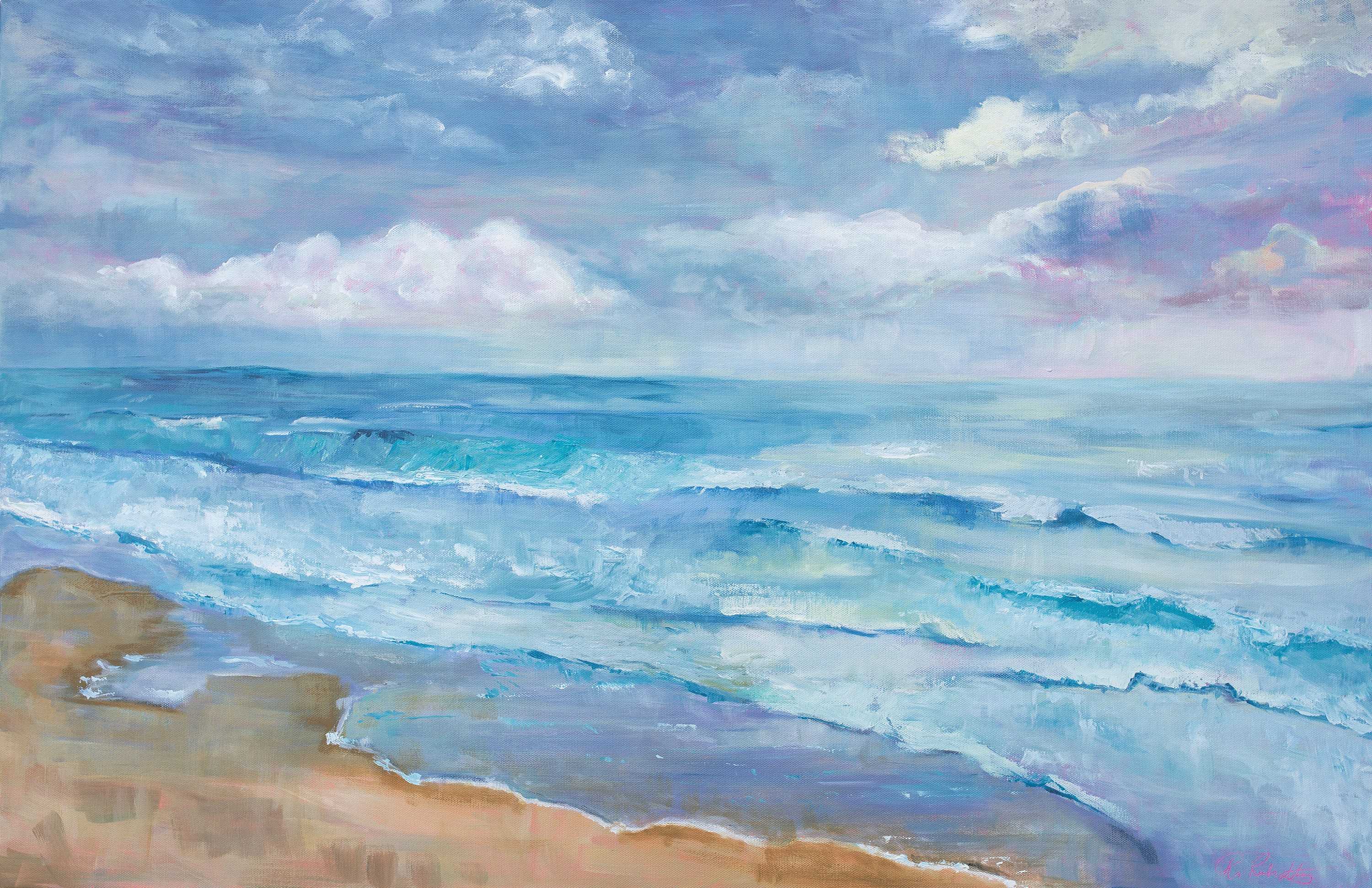Table of Contents
- Exploring the Serenity of Ocean Landscapes in Art
- Techniques and Styles that Capture the Majesty of the Sea
- Choosing the Perfect Ocean Painting for Your Space
- The Emotional Impact of Ocean-Themed Artwork on Home Decor
- Q&A
- The Way Forward


Exploring the Serenity of Ocean Landscapes in Art
Ocean landscapes have captivated the imagination of artists throughout history, serving as a profound source of inspiration. The vastness of the sea, combined with its ever-changing colors and textures, creates a dynamic aesthetic that reflects not just beauty but also tranquility. Artists often employ various techniques such as brushwork and color palettes to convey the serenity found in these majestic waters, drawing viewers into a meditative experience. The color blue, synonymous with the ocean, is particularly effective in evoking feelings of calmness and peace.
One standout characteristic of ocean paintings is the way they can transport viewers to a different time and place. Capturing moments like the delicate interplay of sunlight on waves or the soft hues at sunset allows artists to create immersive experiences. Consider the work of iconic painters such as Claude Monet or Hokusai, whose pieces not only depict the ocean’s beauty but also evoke a sense of nostalgia. Each brushstroke tells a story, manifesting the emotional connection we share with nature.
Furthermore, the depiction of the ocean in art often transcends mere representation. It can convey deeper meanings and societal reflections, including themes of freedom, isolation, and the human experience. For instance, the stormy seas in some artworks symbolize tumultuous emotions or struggles, while tranquil waters may represent peace and hope. The ocean, in its vastness, serves as a metaphor for our dreams and aspirations, showcasing the duality of nature’s grandeur.
To illustrate the diverse interpretations of ocean landscapes in art, consider the following table highlighting notable works and their thematic significance:
| Artwork | Artist | Thematic Element |
|---|---|---|
| Impression, Sunrise | Claude Monet | Transcendence |
| The Great Wave off Kanagawa | Hokusai | Power of Nature |
| Wanderer above the Sea of Fog | Caspar David Friedrich | Isolation |
Through these various interpretations, ocean landscapes in art unify viewers around themes of nature and human emotion, emphasizing our intrinsic connection to the sea. The endless horizon depicted in ocean paintings beckons us to explore our own depths, encouraging reflection in each brushstroke’s serene embrace.
Techniques and Styles that Capture the Majesty of the Sea
When it comes to depicting the vast and ever-changing beauty of the ocean, artists have developed a multitude of techniques that effectively convey its majesty. Watercolor, with its fluid and translucent qualities, allows for soft blending of blues and greens, creating gentle waves and shimmering reflections that dance across the surface. Acrylics, on the other hand, offer vibrant hues and textures, making it possible to capture the energy of crashing waves and the intensity of a stormy sea. Artists often experiment with layering techniques, building depth and dimension that draws the viewer into the scene.
Another distinctive style is impasto, where thick layers of paint are applied to create a three-dimensional effect. This technique is particularly effective for showcasing the tumultuous nature of the sea, as it adds a tactile quality that mimics the foam and turbulence of water. Moreover, some artists embrace abstract interpretations, using bold colors and shapes to evoke the emotional resonance of the ocean rather than an exact likeness. This approach invites viewers to engage with their own feelings about the sea and its vastness.
Adding to the narrative of ocean paintings is the use of color palettes that resonate with the viewer. The interplay of cool and warm tones can communicate different moods—tranquility versus turmoil. Artists will often refer to a color wheel or experiment with complementary colors to achieve striking contrasts that pop off the canvas. For example, the use of deep navy blues paired with bright coral hues can evoke a lively marine environment, while muted grays and soft whites might convey a misty, serene shoreline.
| Technique | Effect | Best Use |
|---|---|---|
| Watercolor | Soft blends and reflections | Calm ocean scenes |
| Acrylic | Vibrant colors and textures | Dynamic wave action |
| Impasto | Three-dimensional surfaces | High-energy seascapes |
| Abstract | Emotion through color and shape | Conceptual ocean themes |
Incorporating these various techniques not only enhances the visual appeal of ocean paintings but also invites viewers on a journey of exploration. The sea’s moods fluctuate with the weather, and so too can the expression of those moods in art. By mastering these styles and methods, artists are able to create works that resonate deeply, allowing the essence of the ocean to be felt even from a distance.


Choosing the Perfect Ocean Painting for Your Space
When it comes to selecting the ideal ocean painting for your space, it’s essential to first consider the mood you wish to create. Ocean artwork can evoke a range of emotions, from tranquility to excitement. To help guide your choice, reflect on the ambiance you want in the room. For instance:
- Calm and Serene: Choose soft blues and gentle waves.
- Vibrant and Energetic: Opt for bright colors and dynamic ocean scenes.
- Moody and Dramatic: Darker palettes with stormy seas can set a more intense mood.
Next, consider the size of your space. The scale of the painting can greatly impact how it complements your room. A large canvas can become a stunning focal point in open areas, while smaller pieces can enhance intimacy and detail. Here are some tips for sizing:
- Oversized Pieces: Ideal for large walls, creating a statement.
- Medium-sized Art: Versatile for various placements and can be grouped.
- Small Paintings: Great for accentuating shelves or creating gallery walls.
Color palette plays a key role in harmonizing your ocean painting with your existing decor. Check how the tones in the artwork resonate with your furnishings and wall colors. A well-blended color scheme helps create a cohesive look. Explore these options:
- Complementary Colors: Choose artwork that has hues that align with your decor.
- Monochromatic Looks: Stick with varying shades of one color for a unified feel.
- Contrasting Choices: Bold, contrasting colors can liven up minimalist decor.
Lastly, do not overlook the framing of your sea-themed piece. The right frame can elevate the painting and integrate it seamlessly into your space. Consider materials and styles that can enhance the artwork:
| Frame Style | Best Suited For |
|---|---|
| Wooden Frames | Coastal or Rustic Decor |
| Metal Frames | Modern and Industrial Styles |
| Gallery Frames | Contemporary Art Displays |


The Emotional Impact of Ocean-Themed Artwork on Home Decor
The allure of ocean-themed artwork transcends mere aesthetics; it evokes deep emotional responses that can enhance the home environment. The vibrant colors and dynamic movements portrayed in these pieces have the power to transport viewers to serene coastal shores, providing a sensory escape from daily stresses. This art form frequently brings a sense of calm and tranquility, which can be essential in creating a peaceful home ambiance.
When displayed strategically within living spaces, such artwork can also serve as a focal point, sparking conversation and connection among family and friends. The symbolism of the ocean—reflecting vastness, depth, and beauty—draws people in, inviting them to explore the stories behind each piece. Whether it’s a sweeping landscape or a close-up of ocean life, the connection created with the artwork can revive cherished memories of beach outings, vacations, and cherished moments by the water’s edge.
Additionally, integrating these pieces can align beautifully with other elements of interior design. For instance, pairing ocean-themed paintings with natural textures like driftwood, soft textiles, and marine-inspired colors can create a cohesive aesthetic that resonates throughout the space. A well-curated collection of ocean art can also contribute to a sense of harmony, inviting elements like blue and turquoise shades to mingle with the surrounding decor, promoting a unified, soothing environment.
Ultimately, ocean-themed artwork is not just decoration; it acts as a medium for emotional expression and environmental connection. Its presence in a home can uplift spirits, provoke contemplation, and encourage relaxation, reinforcing the profound impact of nature on our well-being. By thoughtfully incorporating these pieces, homeowners can cultivate a personal oasis that resonates with their heart and soul.
Q&A
Q&A: All About Ocean Paintings
Q: What are ocean paintings? A: Ocean paintings are artistic interpretations that focus on marine landscapes, depicting various elements of the ocean—such as waves, beaches, sunsets over the water, and marine life. These artworks evoke feelings of tranquility, adventure, and the beauty of nature.Q: What is the significance of ocean themes in art? A: Ocean themes in art resonate deeply with human emotions. The vastness of the sea can symbolize freedom, exploration, and the unknown. Artists often use the ocean as a backdrop to express ideas about life, nature’s power, and the necessity of preserving our planet’s waters.
Q: What materials are commonly used in creating ocean paintings? A: Artists commonly work with oil paints, acrylics, watercolors, or pastels. Each medium offers unique qualities; for instance, oil paints can create rich textures and depth, while watercolors might capture the soft fluidity of waves.
Q: Who are some famous artists known for ocean paintings? A: Several renowned artists have captured the essence of the ocean, including Claude Monet, whose impressionistic seascapes convey light and movement, and Winslow Homer, known for his realistic depictions of the power and beauty of the sea. Contemporary artists also explore ocean themes, bringing fresh perspectives to this timeless subject.
Q: How can ocean paintings influence interior design? A: Ocean paintings can bring a sense of calmness and serenity to a space. They often serve as focal points in living rooms, bedrooms, or offices. Choosing art that reflects the colors and mood of your space can enhance the overall ambience and create a serene environment, reminiscent of a coastal escape.
Q: Are there different styles of ocean paintings? A: Absolutely! Ocean paintings can be found in various styles, from impressionistic and realistic to abstract. Impressionistic works might emphasize light and color, while abstract pieces might portray the emotional essence of the ocean through unconventional shapes and forms. Each style resonates differently with viewers, making ocean art versatile and appealing.
Q: Can ocean paintings help raise awareness about environmental issues? A: Yes, many artists use ocean paintings to highlight environmental challenges facing our oceans, such as pollution and climate change. By bringing attention to these issues through their artwork, they can inspire viewers to appreciate and protect marine ecosystems.
Q: How can one start collecting ocean paintings? A: Beginning a collection can start with understanding your taste and budget. Visit local galleries, art shows, or online platforms specializing in ocean artwork. Engage with artists, attend exhibitions, and don’t hesitate to ask questions to deepen your appreciation of the pieces you’re drawn to.
Q: What tips do you have for creating my own ocean painting? A: Start by gathering inspiration from photographs or nature. Experiment with different techniques like blending colors to represent waves or using palette knives for texture. Don’t be afraid to embrace abstraction or personal interpretation; what matters is expressing your own connection to the ocean.
Q: Where can I find ocean paintings to purchase? A: Ocean paintings are available at numerous venues, including art galleries, online marketplaces, and local art fairs. Websites like Etsy and Saatchi Art feature a wide array of styles, while auctions can also offer unique pieces from established artists.
With this Q&A, readers can explore the fascinating world of ocean paintings, understanding both the artistic process and the deeper meanings behind them. Whether you’re an art lover, a collector, or a budding artist, the sea’s inspiration is boundless.
